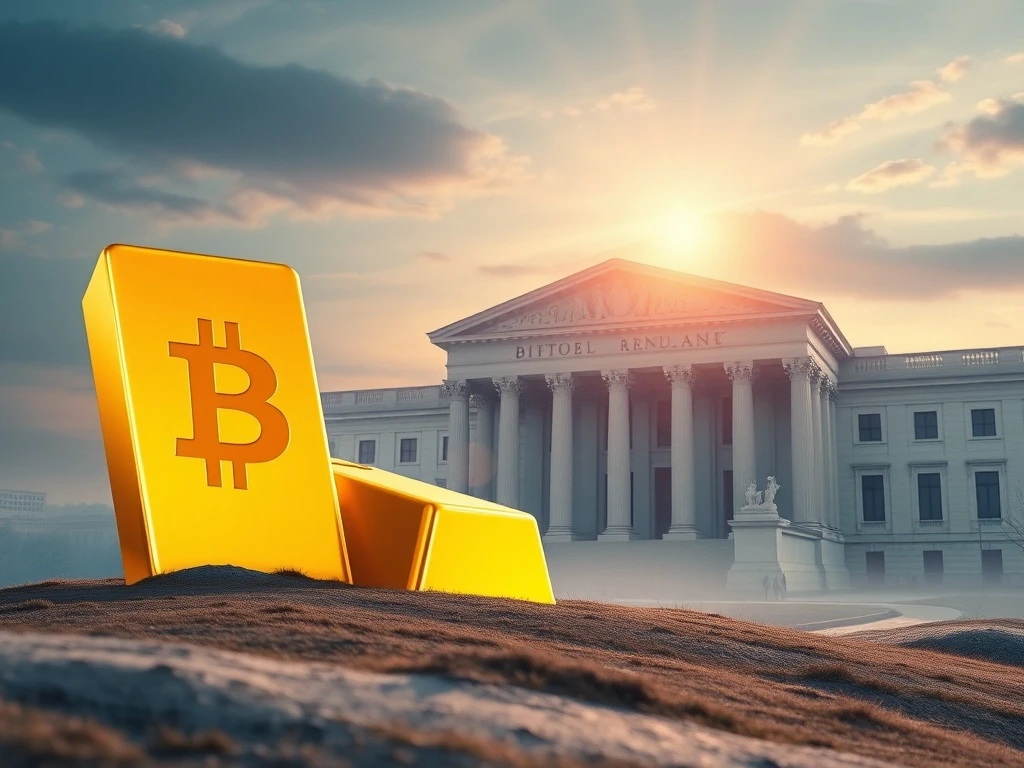Bitcoin’s Ascendant Path: Why Gold’s Central Bank Boom Signals a Powerful Future

The financial world constantly evolves. Consequently, investors and policymakers seek stable assets. Many watch Bitcoin with growing interest. Its journey mirrors a significant shift in global finance. This shift also includes a notable boom in gold buying. A recent Deutsche Bank report highlights these parallels. It suggests Bitcoin could soon join gold as a key reserve asset. This prospect excites many in the cryptocurrency community. It signals a potential future where digital assets hold sovereign importance.
The Resurgence of Gold and its Impact on Central Bank Reserves
Global central banks are significantly increasing their gold holdings. This trend marks a profound shift in global financial strategy. For instance, gold’s share of central bank reserves reached 24% in Q2, its highest since the 1990s. Deutsche Bank strategists confirmed this finding. Official demand for gold now runs at twice the pace of the 2011–2021 average. This renewed accumulation echoes historical financial behaviors. It reflects a growing desire for tangible assets amid economic uncertainty. Furthermore, this move by central banks provides a fascinating backdrop. It shows how traditional finance views store-of-value assets. Therefore, this gold buying boom sets a precedent. It shapes expectations for other non-fiat assets, like Bitcoin.
Gold’s Inflation-Adjusted Highs and Historical Context
Gold recently achieved a remarkable milestone. It surpassed its inflation-adjusted all-time highs from 1980. This event happened only in recent weeks, according to Deutsche Bank strategists. This long delay in reaching real-adjusted peaks has several historical reasons. Decades of central bank selling contributed significantly. Forced institutional gold sell-offs also played a role. The rise of the fiat currency era further diminished gold’s formal status. The International Monetary Fund (IMF) ended gold’s role as a formal reserve asset in 1979. This occurred eight years after the collapse of Bretton Woods. Consequently, gold’s market behavior changed. Its recent resurgence, however, signals a renewed confidence. It highlights its enduring appeal as a hedge against inflation.
Bitcoin: A Strong Contender for a Future Reserve Asset
Amid gold’s impressive performance, attention turns to Bitcoin. Deutsche Bank’s macro strategist Marion Laboure sees compelling parallels. Her report, “Gold’s reign, Bitcoin’s rise,” details these similarities. These observations potentially position Bitcoin as an appealing store of value. Here are key parallels identified by Laboure:
- Both assets exhibit significant similarities in performance trajectories since their inception.
- Historically, both gold and Bitcoin have experienced high volatility. They also endured periods of underperformance.
- Both assets show low correlation with traditional financial assets. This offers notable diversification benefits for portfolios.
Therefore, Bitcoin presents a unique proposition. Its digital scarcity and decentralized nature appeal to many. These features mimic some of gold’s traditional strengths. As a result, the discussion around Bitcoin as a legitimate reserve asset gains traction. This further solidifies its position in global financial dialogues.
Overcoming Hurdles: Bitcoin’s Path to Central Bank Adoption
Despite strong parallels, Bitcoin faces significant hurdles. Marion Laboure acknowledged these challenges. She noted its high volatility as a primary concern for central bankers. The argument that Bitcoin is “backed by nothing” also persists. However, Laboure highlighted a crucial development: “Volatility, however, has now fallen to historic lows.” This reduction addresses a major objection. Other concerns include Bitcoin’s limited usage as a transactional currency. Perceived risks, its speculative nature, and cyber vulnerabilities remain. Liquidity constraints also present challenges. Nevertheless, institutional interest in Bitcoin continues to grow. Some governments are even exploring holding Bitcoin. They consider it part of their strategic reserves. This evolving landscape suggests a potential shift. Central banks might increasingly consider Bitcoin as a viable asset. The Deutsche Bank analysis reflects this changing sentiment.
Deutsche Bank’s Bold Prediction: Gold and Bitcoin by 2030
Marion Laboure made a striking prediction. She suggested both Bitcoin and gold “may both feature on central bank balance sheets by 2030.” This forecast highlights their shared characteristics. Both assets function as “safe-haven” investments. They offer protection during economic instability. This perspective from Deutsche Bank arrives amid increasing institutional Bitcoin adoption. Governments worldwide show rising interest in Bitcoin. They consider it for their strategic reserves. However, Bitcoin’s price volatility remains a key concern. Central bankers prioritize preserving the value of their reserve assets. Thus, stability is paramount. The journey to widespread central bank Bitcoin adoption requires continued maturation. Further regulatory clarity is also essential. Ultimately, this prediction signals a transformative decade ahead.
Conclusion: A New Era for Reserve Assets
The convergence of gold’s resurgence and Bitcoin’s growing maturity is undeniable. Deutsche Bank’s analysis offers valuable insights. It suggests a future where digital assets hold significant weight. Central Bank Reserves are undergoing a quiet revolution. Bitcoin’s journey from niche asset to potential global reserve is a testament to its resilience. As 2030 approaches, the financial world watches closely. The integration of Bitcoin into sovereign portfolios could redefine global economics. This would mark a truly historic shift. Investors and institutions alike must prepare for this evolving landscape.












